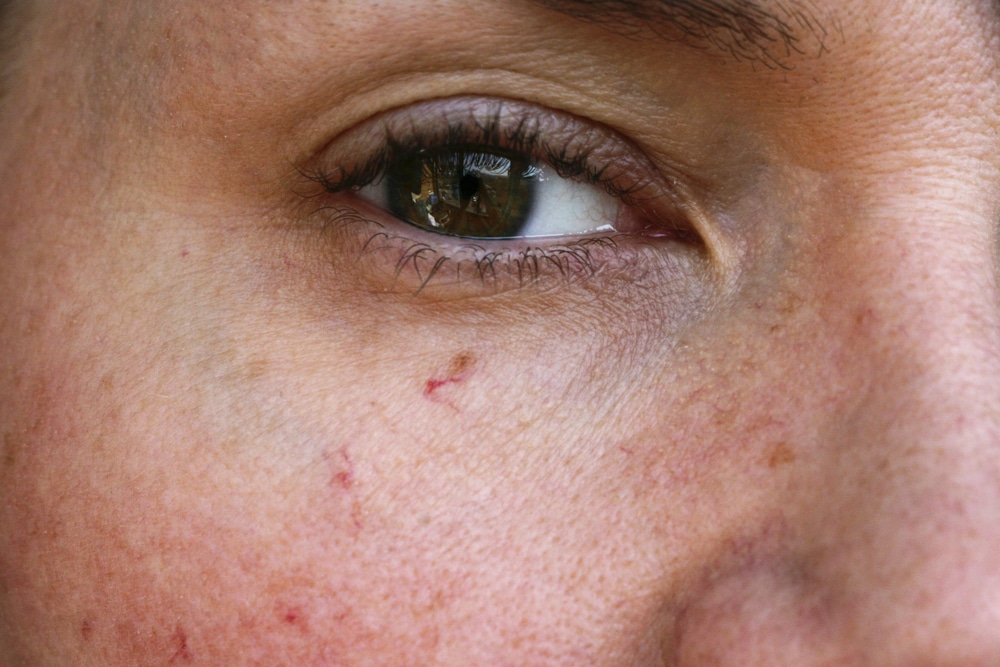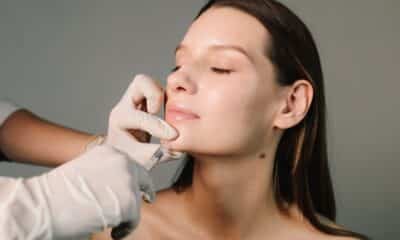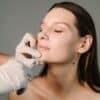What Are Facial Spider Veins? And Why Do We Get Them?
As you peer into the mirror, your gaze is drawn to the delicate web of reddish lines crisscrossing your cheeks and nose. You can’t help but wonder, what exactly are these? Typically, these lines are broken blood vessels on your face.
According to Joshua Zeichner, MD, the director of cosmetic and clinical research in dermatology at Mount Sinai Hospital in New York City, these are dilated capillaries, which are tiny blood vessels that have become visible. They can occur elsewhere on the body such as the neck, chest, or legs (commonly known as spider veins).
Broken facial blood vessels often appear in individuals with lighter skin tones, as noted by Dr. Zeichner. Generally, they’re not a health concern, but if they’re bothersome, treatment options are available.
Continue reading to uncover the causes of broken blood vessels on the face, and how you can prevent and handle them.
What Causes Broken Blood Vessels on the Face?
Numerous factors may predispose individuals to developing facial broken blood vessels, such as:
1. Genetic Influence
Your genes might be the culprits behind the appearance of those blood vessels on your nose and cheeks. Dr. Zeichner points out that those with fair skin or a familial history of skin conditions like rosacea are particularly susceptible to these capillaries.
2. Skin Conditions Including Rosacea
If you’re wrestling with rosacea, this may be contributing to your broken blood vessels. Characterized by facial redness, rosacea patients often have these tiny red lines, explains Dr. Zeichner.
Triggers such as hot foods, alcoholic drinks, hot beverages, and emotional stresses can exacerbate rosacea’s symptoms, leading to more pronounced facial redness over time.
3. Sun Damage
Regularly exposing your skin to the sun without protection can damage the support structures of your skin, such as collagen and elastin, and promote the formation of new blood vessels, states Dr. Zeichner.
4. Alcohol Intake
Your beloved evening drinks might play a role in making existing blood vessels expand and even encourage new ones to form, according to Dr. Zeichner.
5. Post-Operative Effects
Post-surgery marks on the skin could signal the creation of new blood vessels as your skin heals, mentions Dr. Zeichner. Such facial procedures might reveal more noticeable capillaries as a result.
6. Physical Exertion
Any act that forces pressure into the face (like crying, sneezing, vomiting, and other strenuous activities) may cause capillaries to rupture, says Dr. Zeichner.
Small spots called petechiae, while similar in appearance to broken blood vessels, are actually tiny bruises from leaking capillaries, not an outbreak of new vessels.
If you experience petechiae along with other symptoms, medical advice is suggested as they may indicate an underlying issue that calls for therapy such as antibiotics or other medications.
7. Pregnancy and Childbirth
Pregnancy can also lead to the visibility of facial capillaries due to hormonal fluctuations. In addition, the physical strain of giving birth may temporarily cause broken blood vessels.
8. Natural Aging Process
As you grow older, you may notice more facial broken blood vessels. This can result from cumulative environmental damages and other repeated minor skin traumas.
Can Facial Broken Blood Vessels Heal?
Unfortunately, these vessels tend to be a lasting change, Dr. Zeichner explains. However, there are treatments available if you find them cosmetically unappealing.
Leaky capillaries that result in bruises, unlike broken blood vessels, are typically short-term and fade away naturally.
Approaches to Treating Facial Broken Blood Vessels
To permanently eliminate facial broken blood vessels, professional dermatological treatment is usually required. “Laser therapy is the most definitive method,” Dr. Zeichner says. It’s a non-surgical treatment that employs light energy to selectively target and eradicate these veins. Factors like the size of the veins and number of treatments can affect the clearing process, which may take several months.
Although laser treatments can be costly and are typically not insurance-covered, there are budget-friendly home strategies you can use to lessen the appearance of these vessels:
- Regular Moisturizing: Keeping your skin barrier healthy is essential, as hydrated skin can soothe inflammation, according to Dr. Zeichner. Daily application of skin lotion is recommended.
- Hydration: Drinking plenty of water is beneficial for your skin’s moisture and elasticity, as identified in a 2018 review in Skin Research and Technology.
- Using Retinol Cream: Over-the-counter retinol can have a positive effect by improving skin texture and fostering collagen production, potentially reducing the visibility of broken blood vessels. Products containing moisturizing agents like hyaluronic or lactic acid are an added bonus.
Strategies to Prevent Broken Blood Vessels
While it’s not always possible to prevent broken capillaries from forming on the face, you can take certain steps to minimize their occurrence. By understanding the various influences, you can better manage your skin’s appearance and health.
To reduce the risk of spreading blood vessels on your visage, take heed of Dr. Zeichner’s advice:
- Keep your skin’s barrier robust and supple by applying a daily moisturizer.
- Apply a broad-spectrum sunscreen with an SPF of at least 30 every day to shield your skin from the sun’s rays.
- Avoid things that can cause your face to become red, like hot foods, stress, alcoholic drinks, and steaming hot drinks.
- Stay hydrated by drinking a good amount of water.
Knowing When to Consult a Doctor
Although they may be unsightly, broken blood vessels are typically not a cause for concern. However, if you notice a new grouping of tiny blood vessels along with other symptoms, you might be facing a more significant dermatological or health problem, warns Dr. Zeichner. Consider the following examples:
- Rosacea might be the culprit if you have tiny red bumps, pimples filled with pus, or a sensation of burning and stinging on your face along with redness.
- If you experience redness particularly around your nose and cheeks, sensitivity to sunlight, and joint discomfort, it could be indicative of an autoimmune disorder such as lupus.
If you’re experiencing any of these signs, it’s recommended to seek advice from a dermatologist. They have the expertise to ascertain the underlying issue, outline possible treatments, and if necessary, point you to another medical practitioner for further assistance.
Frequently Asked Questions
Are there other reasons for facial redness?
Besides rosacea and broken blood vessels, various other factors can cause your face to appear flushed. According to the American Academy of Dermatology Association (AAD), other causes for a reddened face include:
- Seborrheic dermatitis: This frequent skin condition leads to a red rash, typically on the face, and can cause oiliness, as well as dry and flaky skin.
- Contact dermatitis: This results from skin irritation or an allergic reaction caused by contact with a particular substance.
- Drug reactions: Some medications provoke a reaction akin to sunburn once exposed to sunlight.
- Atopic dermatitis (or eczema): This skin ailment can lead to a red, dry, flaky, and itchy rash.
- Psoriasis: A disorder that makes the body produce skin cells too swiftly, causing thick, scaly patches.
- Shingles: A condition characterized by a painful, blistering rash that could show up on any part of the skin, including the face.
- Lupus: An autoimmune disease that can lead to redness and swelling on the skin, and sometimes a butterfly-shaped facial rash over the nose and cheeks.
- Sézary syndrome: A rare kind of cancer that originates in the T-lymphocytes, which are a type of white blood cell present in the skin.
If redness in your face persists for more than two weeks without improvement, it’s time to see a dermatologist. With numerous possible conditions—some of which are serious—it’s vital to secure a proper diagnosis, says the AAD.
What leads to broken capillaries on a child’s face?
Even though broken blood vessels are a more common issue as we age, children aren’t immune to them. They too can develop these tiny, spider-vein patterns on their faces due to heredity and environmental factors like too much sun, notes the Nicklaus Children’s Hospital. These fine lines are typically harmless concerning your child’s health, but you should still consult a pediatrician if you’re worried.
What’s behind the broken capillaries seen on legs?
Spider veins on the legs occur when delicate blood vessels near the skin’s surface become weak and expand. While the exact cause is unclear, potential reasons, according to the Cleveland Clinic, may include:
- Alterations in hormonal levels
- Genetic conditions
- Connective tissue disorders
- Physical injury or trauma
Factors increasing the likelihood of developing leg spider veins, as reported by the Cleveland Clinic, encapsulate:
- Long periods of standing or sitting
- A family history of spider or varicose veins
- Excess body weight
- Being in a state of pregnancy
- The use of hormonal contraceptives
- Hormonal treatments for menopause symptoms
- Frequent sun exposure
- Smoking, whether current or past
















